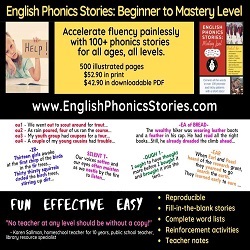 Author Nancy D. Nelson
Author Nancy D. Nelson
541/797-0002
[email protected]
www.englishphonicsstories.com
Assessed by Valerie Schuetta, M.Ed.
Whether you are a parent homeschooling your child, or a teacher looking for new materials to supplement your classroom, look no further. English Phonics Stories, by Nancy D. Nelson, has everything you need to supply your child or students with what they will need to become successful, fluent readers.
As a first grade teacher and Reading Specialist, I am always on the hunt for new materials, especially towards the end of the school year, which is when I begin to think about the next year’s instruction, especially in reading. I like to keep things fresh and progressive. I know that each year will bring me a new classroom of diverse learners. I keep materials that work and let go of what does not. I am always willing to try something new. Some of my reading tools have remained in my toolbox year after year. When I come across new materials that looks promising, I get very excited. English Phonics Stories definitely fell into my “teacher radar”!
There are very many wonderful components in this program! My rule of thumb when teaching, is if I am excited about teaching new material to my students, I know they will be too. I want my enthusiasm to be contagious and I am definitely enthusiastic about English Phonics Stories!
There is a Christian and General version of the English Phonics Stories. Both focus on character building, which is so important to learn at a young age. The only difference is that in the Christian version, the characters pray for others. The Christian version also presents Gospel or Bible verses. It is appropriate for Protestant, Catholic, and Orthodox Faiths. The stories are great for children, teens, as well as adults. The General version contains a General Manual and workbook of the same teaching concepts without the biblical stories.
English Phonics Stories contains all the phonograms and spelling patterns that your child needs to learn to become a fluent and capable reader, and this is exactly what I strive for in my own classroom. I try to leave no stone unturned. I have a potpourri of students, including English language learners, gifted students, resource students, and different learning styles with a variety of multiple intelligences. I know it sounds daunting, but I love the challenge it presents. You see, I want them all to succeed! I know they will with English Phonics Stories.
When each new sound, phonogram, or spelling pattern is introduced, it includes a list of all the words that contain that particular sound or pattern. A delightful illustrated story follows. After this is mastered, a workbook page is assigned to reinforce the learned skill or pattern to be mastered. The theory behind this approach is: Why must children learn all the words that contain particular spelling patterns or sounds over years of reading and schooling? The author, also an educator, believes children will benefit from learning them all and once in a list and get it over with!
I like this approach! Every year, as a public school teacher I see more and more students who are being considered for reading intervention pull-out programs. I believe English Phonics Stories is perfect and compatible for supplementing with my already skill-based phonics and literature program, so many of my students will not need any intervention! I would use this as a way of intervening myself. After all, when students receive reading intervention, they often must leave my classroom to work with a trained Instructional Assistant who implements the intervention. I have never been happy about my students leaving my classroom. It makes me feel like one of my birds has fallen from my nest. Not only is it disruptive, but I feel that they are missing out important small group instruction with me, their classroom teacher. I want to be the one to intervene with my students. With English Phonics Stories, this can become a reality!
There are more than 100 spelling patterns in the English Phonics Stories Manual, including over 100 beautifully illustrated stories. Each vowel sound or spell pattern includes a word list and an illustrated story. These include long and short vowels, double consonants, long vowels followed by silent e, broad a at the end of a word, suffixes, prefixes, and so much more, including my favorite, French -ch. The real beauty of this program is that it does not take any special training to use it. It is perfect for classroom teachers, as well as homeschooling parents. I plan on using it as a supplement with my required materials, but it is beautifully put together for a homeschooling parent and very easy to comprehend. It does not require any special training or certification to implement.
What I like about this program the most is that it is a great program for differentiation. In other words, it covers all the learning styles, multiple intelligences, English language learners, and children with learning differences. I would have loved to have had this program last year with my classroom, as they were all English language learners. The main components of teaching ELL (English language learners) are reading, vocabulary, comprehension, and grammar. This program supplies all of these. I know my ELL children would have loved the beautifully illustrated stories!
The program also appeals to all the different learning styles children possess. Over the years, many people have asked me how it is possible to teach to every child’s unique learning style. I always reply that it is not that difficult. All you need is a program that covers all the bases, and English Phonics Stories hits it out of the park! For example, most children love to learn to music, dancing, and poems. There are many poems included along with a complete list of Orton-Gillingham phonogram list. These poems can be easily sung to a tune to engage all my musical and kinesthetic learners. If they are up and moving about while singing and reciting the poems, all the better!
English Phonics Stories includes a list of words that contain the focused spelling pattern, vowel or consonant sound, or phonogram. The only prerequisite is that the child must know all of their consonant sounds and the alphabet, which is usually what is expected in a school setting for first grade. The words on this list are embedded in an engaging story, complete with illustrations. The workbook has fill-in-the-blank activities that are reproducible.
This is a very flexible program. I love the fact that the word lists include almost all of the words that contain the focused sound. I am a huge proponent of Phonics, but I also know that there are times when words “break rules” and I tell my students that they are just going to have to memorize such words. I like to tell them to take a picture of it with their brain. The word lists included in this program are meant to be memorized. When I implement this program, I plan on going over the word list with my students first, reading the story 2-3 times, and completing the corresponding workbook page. I would have them read the story more than once because I would have them do a silent, timed reading, maybe a minute, orally read the story with me, and read again. I would also have them go back and identify words that contain the focused sound. I also love the fact that many of the stories are mnemonic. This is a great way to help children remember the spelling patterns! The word lists can also be used for writing in a journal as well and very much more!
English Phonics Stories includes levels from beginning to mastery levels, so it can be used for all ages. This is also important for differentiation. I am sure you will use and find English Phonics Stories an incredibly important foundation for your literacy instructional needs. I know I will! V.S.



